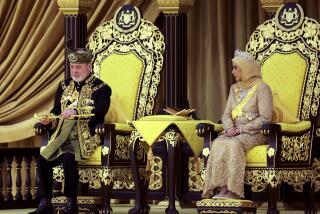Growing Pains Hit Malaysian Economy : Development: For the last seven years, the economy grew at 8% or more. But growth has brought traffic, pollution.
- Share via
KUALA LUMPUR, Malaysia — This city is booming so much you can watch it grow before your eyes.
The two tallest buildings in the world are under construction, twin towers that are adding a floor every four days. When the Petronas Towers are finished in 1996, they will soar to 1,475 feet, 21 feet higher than the current highest, the Sears Tower in Chicago.
At ground level, the streets are bumper-to-bumper with made-in-Malaysia Proton cars, products of a domestic auto industry that did not exist a decade ago.
Most every downtown corner has gleaming new bank offices, conduits for foreign investment into Malaysia that totaled $5 billion in 1994. All of eastern Europe combined did not draw that much money.
“Our growth is almost too much for anybody to handle,” said Muthi Samudram, a senior researcher at the Malaysian Institute of Economic Research. “But there’s so much momentum I think it will keep going for at least another five years.”
As recently as 1987, this Southeast Asian nation was mired in a recession and had a modest economy based largely on agriculture and oil.
Today, Kuala Lumpur is a breathtaking example of the economic frenzy sweeping the region as it industrializes at a ferocious pace.
For seven straight years, Malaysia’s economy has grown at 8% or more annually. Inflation is around 3% and Prime Minister Mahathir Mohamad, a stern ruler who allows little dissent, wants it down to zero.
There is virtually full employment. The government’s main concern about jobs is keeping out the boatloads of illegal Indonesian immigrants who cross the Straits of Malacca looking for work.
“The management of the economy has been superb,” Jeffrey Sachs, a Harvard University economist who advises developing countries, said during a recent visit to Kuala Lumpur. “I often use Malaysia as a good example that should be followed.”
Mahathir launched a series of economic reforms beginning in 1986. The government began offering tax incentives to lure foreign businesses, lowered taxes on Malaysian businesses and eased export controls, touching off a dramatic rise in exports.
Malaysia also has benefited from the tremendous economic growth in neighboring countries--Singapore, Thailand and Indonesia.
As Malaysia’s business hub, Kuala Lumpur has been transformed from a tin-mining town during the British colonial era into a modern capital dominated by office towers, shopping malls and five-star hotels.
Huge cranes tower over 15 major development projects. The biggest is the City Center, where the Petronas Towers will be part of a 22-building complex spread over a former horse-racing track.
“We want the towers to be the showroom of Malaysian industry,” said Abdul Rahim Naim, chief operating officer for City Center.
The surging economy has produced a solid middle-class that is generally supportive of the government’s pro-business policies. And in a diverse society, all the leading ethnic groups--Malay, Chinese and Indian--have prospered.
But not everyone is thrilled with the breakneck development, which has erased much of the city’s tropical charm and brought traffic, pollution and other urban woes.
Stately, whitewashed homes set among lush gardens are getting harder to find. The elegant railway station, with its minarets creating the appearance of a mosque, is largely obscured by a freeway and skyscrapers.
“Kuala Lumpur is the smallest of all Asian capitals, but we are approaching the traffic nightmares of much larger cities,” said Gurmit Singh, founder of the Environmental Protection Society of Malaysia.
A haze hangs over the city most mornings, and poor planning has resulted in haphazard building and a lack of roads to handle the traffic, Singh added.
With about 2 million residents, Kuala Lumpur is much smaller than such Asian mega-cities as Tokyo, Hong Kong and Beijing. Nonetheless, Mahathir has decided to build a new government center about 25 miles outside town in hopes of easing congestion.
Some economists warn that Kuala Lumpur risks overbuilding and that the economy could be vulnerable if a recession hits. Malaysia has a labor shortage, raising worries about the dangers of wage and price inflation, and stock prices are down.
But for now it is full-speed ahead.
“There’s still a lot of room for improved efficiency and production,” said Muthi Samudram, from the Institute of Economic Research. “When we become a more mature economy, then such growth rates will be difficult to sustain.”
More to Read
Sign up for Essential California
The most important California stories and recommendations in your inbox every morning.
You may occasionally receive promotional content from the Los Angeles Times.













